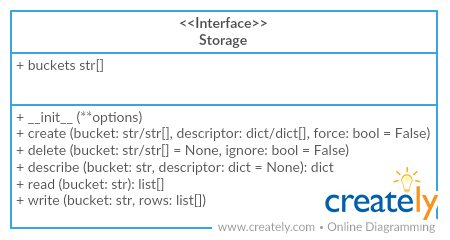No project description provided
Project description
tableschema-spss-py
Generate and load SPSS files based on Table Schema descriptors.
Features
- implements
tableschema.Storageinterface
Contents
Getting Started
Installation
The package use semantic versioning. It means that major versions could include breaking changes. It's highly recommended to specify package version range in your setup/requirements file e.g. package>=1.0,<2.0.
pip install tableschema-spss
Examples
Code examples in this readme requires Python 3.3+ interpreter. You could see even more example in examples directory.
For this example your schema should be compatible with SPSS storage - https://github.com/frictionlessdata/tableschema-spss-py#creating-sav-files
from tableschema import Table
# Load and save table to SPSS
table = Table('data.csv', schema='schema.json')
table.save('data', storage='spss', base_path='dir/path')
Documentation
The whole public API of this package is described here and follows semantic versioning rules. Everyting outside of this readme are private API and could be changed without any notification on any new version.
Storage
Package implements Tabular Storage interface (see full documentation on the link):
This driver provides an additional API:
Storage(base_path=None)
base_path (str)- a valid directory path where .sav files can be created and read. If no base_path is provided, the Storage object methods will accept file paths rather than bucket names.
storage.buckets
List all .sav and .zsav files at base path. Bucket list is only maintained if Storage has a valid base path, otherwise will return None.
(str[]/None)- returns bucket list or None
With a base path
We can get storage with a specified base path this way:
from tableschema_spss import Storage
storage_base_path = 'path/to/storage/dir'
storage = Storage(storage_base_path)
We can then interact with storage buckets ('buckets' are SPSS .sav/.zsav files in this context):
storage.buckets # list buckets in storage
storage.create('bucket', descriptor)
storage.delete('bucket') # deletes named bucket
storage.delete() # deletes all buckets in storage
storage.describe('bucket') # return tableschema descriptor
storage.iter('bucket') # yields rows
storage.read('bucket') # return rows
storage.write('bucket', rows)
Without a base path
We can also create storage without a base path this way:
from tableschema_spss import Storage
storage = Storage() # no base path argument
Then we can specify SPSS files directly by passing their file path (instead of bucket names):
storage.create('data/my-bucket.sav', descriptor)
storage.delete('data/my-bucket.sav') # deletes named file
storage.describe('data/my-bucket.sav') # return tableschema descriptor
storage.iter('data/my-bucket.sav') # yields rows
storage.read('data/my-bucket.sav') # return rows
storage.write('data/my-bucket.sav', rows)
Note that storage without base paths does not maintain an internal list of buckets, so calling storage.buckets will return None.
Reading .sav files
When reading SPSS data, SPSS date formats, DATE, JDATE, EDATE, SDATE, ADATE, DATETIME, and TIME are transformed into Python date, datetime, and time objects, where appropriate.
Other SPSS date formats, WKDAY, MONTH, MOYR, WKYR, QYR, and DTIME are not supported for native transformation and will be returned as strings.
Creating .sav files
When creating SPSS files from Table Schemas, date, datetime, and time field types must have a format property defined with the following patterns:
date:%Y-%m-%ddatetime:%Y-%m-%d %H:%M:%Stime:%H:%M:%S.%f
Table Schema descriptors passed to storage.create() should include a custom spss:format property, defining the SPSS type format the data is expected to represent. E.g.:
{
"fields": [
{
"name": "person_id",
"type": "integer",
"spss:format": "F8"
},
{
"name": "name",
"type": "string",
"spss:format": "A10"
},
{
"type": "number",
"name": "salary",
"title": "Current Salary",
"spss:format": "DOLLAR8"
},
{
"type": "date",
"name": "bdate",
"title": "Date of Birth",
"format": "%Y-%m-%d",
"spss:format": "ADATE10"
}
]
}
Contributing
The project follows the Open Knowledge International coding standards.
Recommended way to get started is to create and activate a project virtual environment. To install package and development dependencies into active environment:
$ make install
To run tests with linting and coverage:
$ make test
For linting pylama configured in pylama.ini is used. On this stage it's already
installed into your environment and could be used separately with more fine-grained control
as described in documentation - https://pylama.readthedocs.io/en/latest/.
For example to sort results by error type:
$ pylama --sort <path>
For testing tox configured in tox.ini is used.
It's already installed into your environment and could be used separately with more fine-grained control as described in documentation - https://testrun.org/tox/latest/.
For example to check subset of tests against Python 2 environment with increased verbosity.
All positional arguments and options after -- will be passed to py.test:
tox -e py27 -- -v tests/<path>
Under the hood tox uses pytest configured in pytest.ini, coverage
and mock packages. This packages are available only in tox envionments.
Changelog
Here described only breaking and the most important changes. The full changelog and documentation for all released versions could be found in nicely formatted commit history.
v1.0
- Initial driver release
Project details
Release history Release notifications | RSS feed
Download files
Download the file for your platform. If you're not sure which to choose, learn more about installing packages.
Source Distribution
Built Distribution
File details
Details for the file tableschema-spss-1.0.14.tar.gz.
File metadata
- Download URL: tableschema-spss-1.0.14.tar.gz
- Upload date:
- Size: 13.9 kB
- Tags: Source
- Uploaded using Trusted Publishing? No
- Uploaded via: twine/2.0.0 pkginfo/1.5.0.1 requests/2.22.0 setuptools/41.6.0 requests-toolbelt/0.9.1 tqdm/4.37.0 CPython/3.8.0
File hashes
| Algorithm | Hash digest | |
|---|---|---|
| SHA256 |
b9c1d4c8b1dc9fc445961212ad4c1673ecc9aab861bc85e57eb2888f9cb573ea
|
|
| MD5 |
147e8831dced4790263f490b02ae6ce7
|
|
| BLAKE2b-256 |
c47cd5466108f55b2a92c86dc3e32888c4087c4642682a47752f5adee7a4c934
|
File details
Details for the file tableschema_spss-1.0.14-py2.py3-none-any.whl.
File metadata
- Download URL: tableschema_spss-1.0.14-py2.py3-none-any.whl
- Upload date:
- Size: 10.0 kB
- Tags: Python 2, Python 3
- Uploaded using Trusted Publishing? No
- Uploaded via: twine/2.0.0 pkginfo/1.5.0.1 requests/2.22.0 setuptools/41.6.0 requests-toolbelt/0.9.1 tqdm/4.37.0 CPython/3.8.0
File hashes
| Algorithm | Hash digest | |
|---|---|---|
| SHA256 |
7decca6399925dafd641a90138658a81e03d78958a53d8e82e963c8360a950d9
|
|
| MD5 |
7ec6b051888eebb1dfc9422d3ddd2e41
|
|
| BLAKE2b-256 |
0918a177547c2228ebe4038dc2548fa7d5e20f4fef10073dd9024efdd483ae7d
|

















